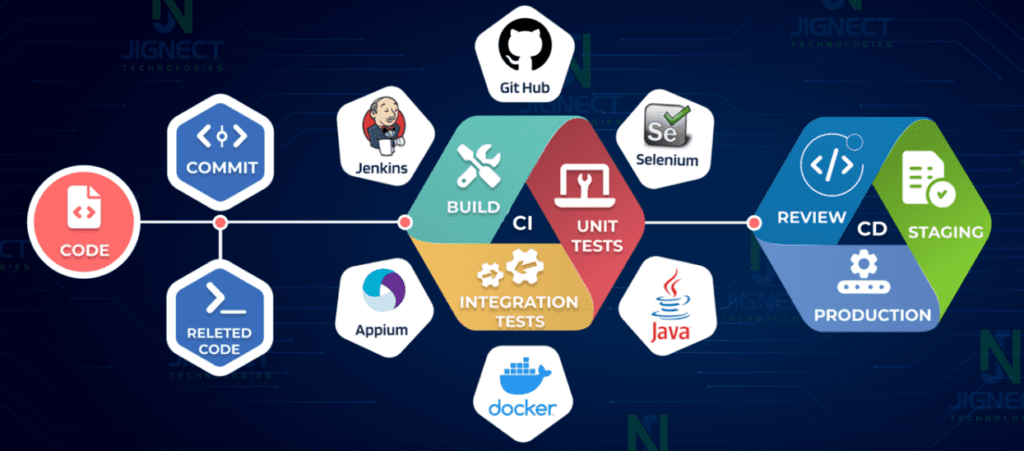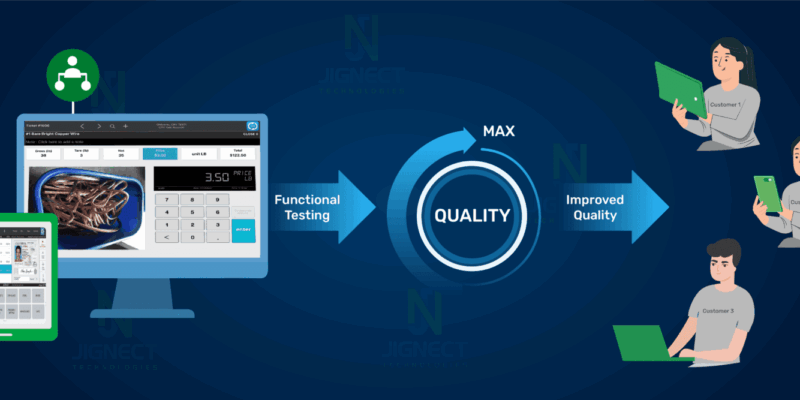Implemented Continuous Integration and Continuous Delivery (CI/CD) pipeline for Software Testing of a Food Ordering Services
Customer :
- Our client is a Netherlands-based company that offers online food ordering services to various establishments such as restaurants, cafes, bars, hotels, and retail outlets.
- The client was facing challenges in their testing process, including manual testing, delayed feedback, and difficulty in maintaining consistent quality across different platforms. As a solution the client decided to adopt a CI/CD approach to automate their testing process, with the goal of achieving faster feedback loops, increased test coverage, and quicker identification and resolution of defects.
- The client approached JigNect with a requirement to improve the efficiency and quality of their software testing process.
Challenges :
- The client was facing challenges in their testing process, including manual intervention, time-consuming regression testing, and delays in identifying and fixing bugs.
- The client’s software testing process was manual and time-consuming, leading to delays in the delivery of software releases.
- The manual process also led to a higher chance of human error and increased the risk of defects in the final product. The client needed a solution that would automate the software testing process and ensure the quick delivery of software releases.
- The client wanted to establish a test framework and automate the testing process, aiming to run the tests daily due to the frequent changes in the Application, such as the addition of new features or modifications to existing ones.
Solution :

To address the client’s challenges, JigNect’s automation team proposed the implementation of CI/CD techniques for software testing. We recommended the use of popular tools such as Jenkins, GitHub, and Docker for automating the software testing process. The team chose Jenkins as their preferred CI/CD tool due to its popularity, flexibility, and extensive plugin ecosystem.
- Source Code Management : The client’s source code was migrated to GitHub, where it was managed and stored in a centralized repository. This allowed the development team to work collaboratively and made it easier to track changes made to the code.
- Automated Builds : Jenkins was used to automate the software build process. The Jenkins server was configured to automatically build the software whenever changes were made to the source code. This eliminated the need for manual builds, reducing the risk of human error.
- Automated Testing : Docker was used to create a testing environment that was separate from the production environment. The testing environment was automatically created and destroyed after each test run, ensuring that the tests were run in a consistent environment.
- Continuous Integration : GitHub was integrated with Jenkins, and the build process was triggered whenever changes were pushed to the repository. This allowed the team to quickly identify any issues and resolve them before they reached the production environment.
- Continuous Delivery : Once the software was successfully tested, it was automatically delivered to the production environment using Docker containers. This reduced the time required to deploy software releases and ensured that the software was deployed consistently across all environments.
- Tools & Technologies :
- Continuous Integration Tool : Jenkins
- Code Repository : GitHub
- Docker
- Automation : Selenium, Appium with Java
Benefits :
The implementation of CI/CD techniques for software testing resulted in the following benefits for the client:
- Improved Efficiency : The automation of the software testing process reduced the time required to perform software tests, leading to improved efficiency and a faster delivery of software releases.
- Improved test coverage : The automated pipeline enabled the team to execute a comprehensive suite of tests, including unit tests, integration tests, and UI tests. This increased test coverage and reduced the risk of potential issues slipping into production.
- Early bug detection : By integrating automated testing into the pipeline, the team could identify and fix bugs early in the development cycle, minimizing the impact on the overall project timeline.
- Increased Quality : The use of Docker containers for testing ensured that the tests were run in a consistent environment, reducing the risk of defects in the final product.
- Reduced Risk : The automatic trigger of builds and tests reduced the risk of human error and ensured that the software was thoroughly tested before being deployed to the production environment.
- Improved Collaboration : The centralized source code repository allowed the development team to work collaboratively, improving communication and reducing the risk of conflicts.
Conclusion :
The implementation of CI/CD techniques for software testing allowed the client to streamline the software testing process and improve the efficiency and quality of their software releases. The use of popular tools such as Jenkins, GitHub, and Docker allowed the team to automate the testing process, reducing the risk of human error and ensuring the consistent delivery of software releases. The results of the implementation showed that CI/CD can significantly improve the software development process, and the client was satisfied with the improvements made to their software testing process.
Witness how our meticulous approach and cutting-edge solutions elevated quality and performance to new heights. Begin your journey into the world of software testing excellence. To know more refer to Tools & Technologies & QA Services.
If you would like to learn more about the awesome services we provide, be sure to reach out.
Happy Testing 🙂



